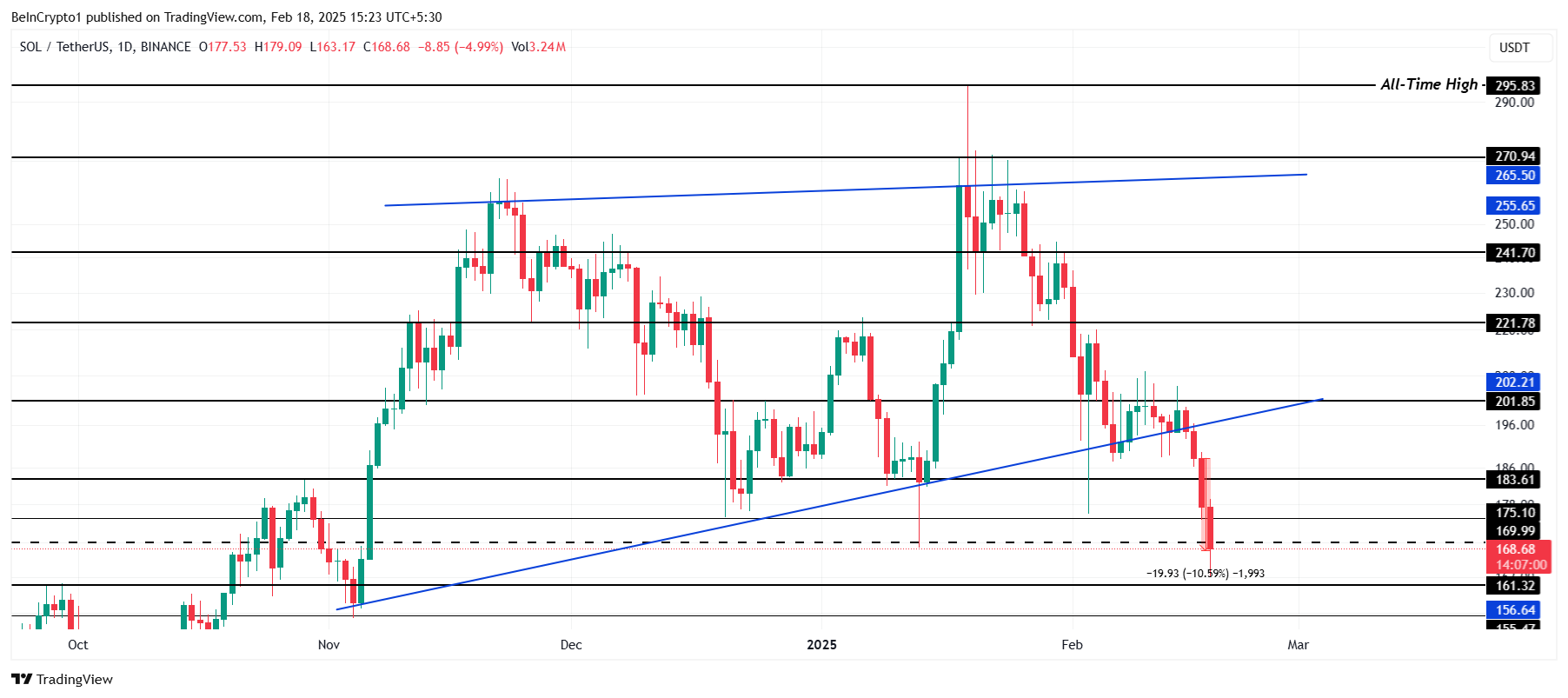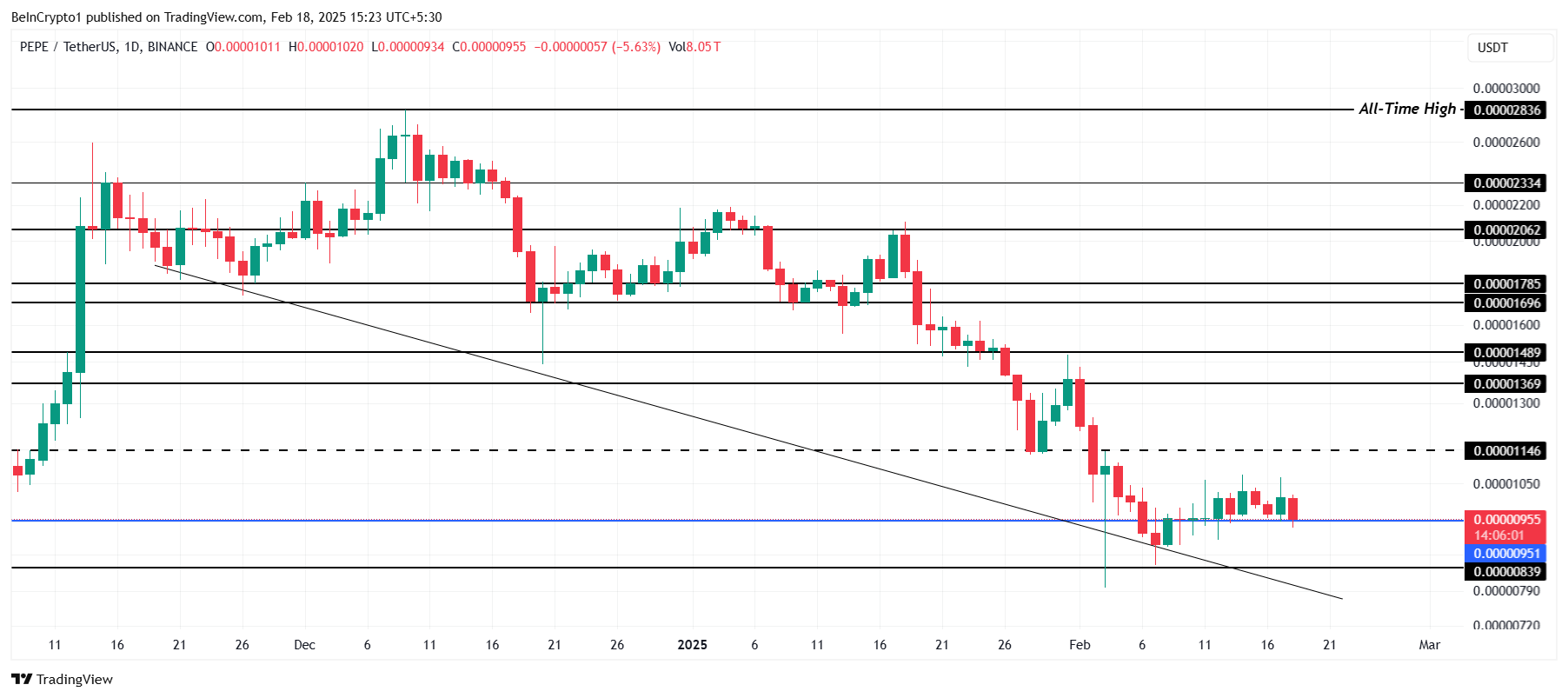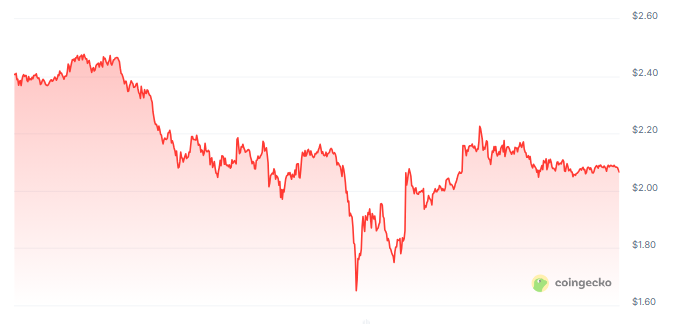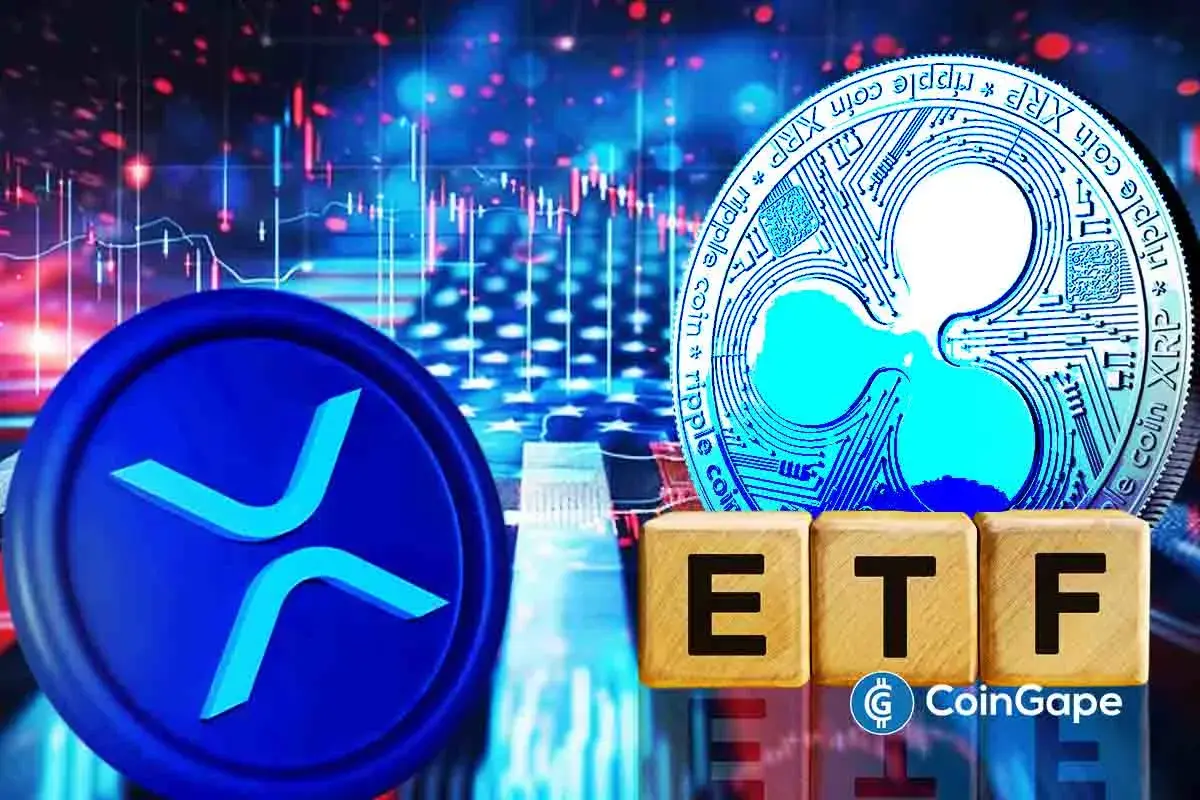Market
Why These Altcoins Are Trending Today — February 18

The crypto market is showing mixed signals, causing some altcoins to climb while others experience declines. However, certain altcoins are catching investors’ attention due to recent developments surrounding the tokens.
BeInCrypto has analyzed three trending altcoins and their potential price movements moving forward.
Solana (SOL)
Solana has been one of the biggest trending tokens today, according to data from Santiment. The attention comes as the Solana-based token LIBRA makes headlines, capturing the interest of investors. However, the attention has been mostly negative, owing to the suspicion that the LIBRA token is a pump-and-dump scheme, which led to significant losses for its investors.
Due to this negative attention, Solana’s price has suffered, falling by 10.5% over the last 24 hours. This price action invalidated the ascending wedge pattern, with SOL currently trading at $168. The altcoin’s failure to maintain upward momentum suggests that short-term bearish pressure may persist.

If the drawdown continues, SOL could face further declines, potentially dropping to $156. Such a drop would extend investors’ losses and may signal prolonged weakness for Solana. However, reclaiming $169 as a support level would help SOL reverse the bearish trend, pushing it toward $175 or $183. This shift would invalidate the current bearish outlook.
Pepe (PEPE)
PEPE’s price recently gained attention as new meme coins attempt to steal its limelight. The rise of these tokens is creating additional competition, potentially impacting PEPE’s demand and traction. Despite this, PEPE continues to hold its ground as one of the top meme coins in the market.
Amid the rising competition from new meme coins, PEPE’s price has remained resilient. Trading at $0.00000995, it is holding above the downtrend support line, signaling stability. This could position PEPE to breach the next resistance at $0.00001146, initiating a recovery towards its previous high of $0.00001369.

However, if PEPE loses the support of $0.00000951, the price could decline to $0.00000839. A drop below this level would invalidate the bullish outlook and increase the risk of extended losses. Investors should monitor key support levels to assess potential price movements.
Chainlink (LINK)
Another one of the trending altcoins, LINK’s price is holding above the downtrend line, which has acted as support since the beginning of the year. Trading at $18.20, the altcoin is positioned to make a potential rebound. If LINK breaches $19.23, it could gain upward momentum and head toward its next resistance levels.
Successfully flipping $19.23 into a support level would signal further bullish momentum for LINK. This would enable the altcoin to target $22.03, a crucial resistance point. A breach of this level would help recover a significant portion of the recent losses, boosting investor sentiment and confidence.

However, if LINK loses the support of the downtrend line, it could fall through the $17.31 support level. In such a scenario, LINK may test $15.62 as the next support, invalidating the bullish thesis and prolonging the ongoing downtrend.
Disclaimer
In line with the Trust Project guidelines, this price analysis article is for informational purposes only and should not be considered financial or investment advice. BeInCrypto is committed to accurate, unbiased reporting, but market conditions are subject to change without notice. Always conduct your own research and consult with a professional before making any financial decisions. Please note that our Terms and Conditions, Privacy Policy, and Disclaimers have been updated.
Market
Charles Schwab Plans Spot Crypto Trading Rollout in 2026


Charles Schwab, one of the largest brokerage firms in the United States, is preparing to launch a spot cryptocurrency trading platform within the next year.
This marks a major move by one of the most trusted names in traditional finance and shows that demand for crypto investment options continues to climb.
Charles Schwab Eyes Crypto Expansion
During a recent earnings call, Schwab CEO Rick Wurster said the firm is optimistic about upcoming regulatory changes that could allow it to fully enter crypto trading.
“Our expectation is that with the changing regulatory environment, we are hopeful and likely to be able to launch direct spot crypto and our goal is to do that in the next 12 months and we’re on a great path to be able to do that,” Wurster explained.
This move would allow the company to offer direct access to spot crypto trading and place it in direct competition with major players like Coinbase and Binance.
While the company already offers crypto-related products such as Bitcoin futures and crypto ETFs, the addition of direct trading would significantly expand its crypto portfolio. According to the CEO, engagement on these products has grown rapidly in recent months.
Wurster revealed that visits to the firm’s crypto-focused content have surged 400%. Of that traffic, 70% came from users who are not yet customers, showing a growing appetite for digital asset investments.
Wurster’s confidence in crypto aligns with the Trump administration’s efforts to introduce a clearer regulatory framework for digital assets. Compared to past years, progress on crypto legislation and oversight has accelerated, especially among key regulatory bodies like the SEC.
If these improvements continue, Schwab could debut its spot crypto trading platform before mid-2026. The firm believes its reputation in traditional finance gives it a strategic advantage in expanding into the crypto space.
Meanwhile, Schwab is already dipping its toes into the sector through its role as custodian for Truth.Fi, an upcoming digital investment platform launched by Trump Media and Technology Group. Truth.Fi plans to offer a mix of Bitcoin, separately managed accounts, and other crypto-linked products.
Indeed, Schwab’s potential entry into the sector has drawn attention from other industry leaders. Asset management firm Bitwise CEO Hunter Horsley described the brokerage firm’s move as a milestone in crypto’s transition to mainstream finance.
Rachael Horwitz, Chief Marketing Officer at Haun Ventures, echoed that sentiment and encouraged Schwab to consider crypto-collateralized lending as a future offering.
“Schwab should implement crypto-collateralized lending as part of its banking services next,” Horwitz said.
Disclaimer
In adherence to the Trust Project guidelines, BeInCrypto is committed to unbiased, transparent reporting. This news article aims to provide accurate, timely information. However, readers are advised to verify facts independently and consult with a professional before making any decisions based on this content. Please note that our Terms and Conditions, Privacy Policy, and Disclaimers have been updated.
Market
Today’s $1K XRP Bag May Become Tomorrow’s Jackpot, Crypto Founder Says

A long-time supporter of XRP who is not afraid to speak his mind has issued stunning predictions concerning the future value of the cryptocurrency. His assertions have both interested and confused investors.
Investor Forecasts 50-Fold Return On XRP
As per the Alpha Lions Academy founder Edoardo Farina, an investment of $1,000 in XRP today can increase to more than $50,000 in the future. The estimate is based on the altcoin crossing Farina’s desired price target of $100 per token, from its current value of around $2.
“Buying $1,000 worth right now is really buying over $50,000 in the future when $XRP hits $100+”, Farina tweeted recently.
Farina previously revealed he will not sell any of his XRP holdings until the price reaches at least $100 per token. He terms the coin as sitting at the hub of what he refers to as a “multi-generational pump” and points out its potential function within the international finance system.
XRP @ $2
Buying $1,000 worth right now is really buying over $50,000 in the future when $XRP hits $100+
50x return
— EDO FARINA 🅧 XRP (@edward_farina) April 18, 2025
Minimum Holdings Suggestion Sparks Skepticism
According to reports, Farina urges retail investors to own a minimum of 1,000 XRP tokens. He asserts that such an amount is the minimum one needs in order to take advantage of the use and greater adoption of XRP in the future.
Such opinions regarding the issue have been unequivocal. Farina has reportedly said that individuals who have fewer than 1,000 XRP tokens “don’t care enough about their financial success” and called possessing less than that amount “insanity.”

Though these comments represent Farina’s individual investment strategy, they echo a developing perception among XRP enthusiasts that the asset is undervalued and poised for strong growth if regulatory clarity increases and more businesses embrace it.
Doubters Challenge The Life-Changing Assertions
Not everyone shares Farina’s positive perspective. Doubters have raised issues with his assertion that $1,000 in XRP today may be worth $50,000 someday.
One critic pointed out that even if XRP hits $100 and converts $1,000 into $50,000, this may not be sufficient for early retirement. The remark points out that what appears to be a good return may not necessarily be the life-altering wealth many investors expect.
Questions also arise regarding if XRP will ever hit the $100 level, and if so, how long it would take to arrive there.
Price Target Timeline Indicates Long Way To Go
The journey to $100 looks long for XRP, which is currently trading at about $2. It would need a nearly 5,000% rise from where it is now to reach $100.
Featured image from Pexels, chart from TradingView
Market
Technical Analyst Warns Ripple’s XRP Price Could drop 50%

Veteran market analyst Peter Brandt has issued a gloomy year-end forecast for XRP, suggesting the asset may struggle to maintain its momentum despite recent gains.
On April 18, Brandt shared his updated analysis on X (formerly Twitter), projecting two possible scenarios for XRP’s market capitalization by year’s end.
Cautionary Outlook for XRP Despite Recent Surge
The first scenario places XRP’s market cap around $116.67 billion, while the second offers a more bearish outlook of just above $60 billion.
Essentially, both figures imply a decline from XRP’s current valuation of roughly $2.09 per token at a market capitalization of $121 billion.

Brandt’s analysis is based on a technical pattern he previously identified on XRP’s price chart.
According to him, the formation resembles a classic head-and-shoulders setup—a pattern that often signals a trend reversal. If this plays out, XRP could fall as low as $1.07.
He added then that a move below $1.90 would confirm the pattern and likely trigger a steep correction of more than 50%. However, a break above $3 could invalidate the bearish outlook.
“XRP is forming a textbook H&S pattern. So, we are now range bound. Above 3.000 I would not want to be short. Below 1.9 I would not want to own it,” Brandt explained.
This cautious forecast follows a remarkable surge in XRP’s price since late 2024.
Following Donald Trump’s return to the White House, the token rallied over 300%, reaching a high of $3.28 before pulling back to its current level.
This price performance has led many investors to believe that the Trump administration’s friendlier stance toward digital assets could help the asset continue its rally.
One major catalyst was the Securities and Exchange Commission’s (SEC) decision to drop several lawsuits against crypto companies, including Ripple.
That shift reduced regulatory uncertainty and sparked renewed interest in XRP, culminating in the launch of exchange-traded funds (ETFs) focused on the product.
Adding to the momentum, Ripple launched its own stablecoin, RLUSD, aiming to tap into a growing segment of the digital asset market.
Still, Brandt’s warning suggests that XRP’s recent rally may not be sustainable if bearish pressure intensifies.
Ripple Not Rushing Into IPO Despite Industry Trend
Amid renewed attention on XRP’s performance, Ripple CEO Brad Garlinghouse has addressed growing speculation about the company going public.
In a recent video shared on X, Garlinghouse made it clear that Ripple does not plan to file for an IPO in 2025.
He emphasized that the company is not actively seeking external funding because it remains financially stable and is prioritizing product development and business expansion.
“Will we IPO in 2025? I think that’s a definitive no…We’ve said there’s no imminent plans to go public,” Garlinghouse stated.
While the company isn’t moving forward with an IPO this year, Garlinghouse didn’t completely close the door.
He noted that Ripple is evaluating whether going public would benefit the business in the long run. However, such a move isn’t a current priority.
“You have to ask yourself, okay, how does Ripple benefit from being a public company? And is it a high priority for us?” he said.
Moreover, Garlinghouse also hinted that the regulatory landscape—especially under new leadership at the SEC—could influence Ripple’s future decisions.
His comments come as several crypto firms, including Kraken and Ciecle, reportedly prepare for IPOs. For now, though, Ripple appears comfortable staying private until conditions become more favorable.
Disclaimer
In adherence to the Trust Project guidelines, BeInCrypto is committed to unbiased, transparent reporting. This news article aims to provide accurate, timely information. However, readers are advised to verify facts independently and consult with a professional before making any decisions based on this content. Please note that our Terms and Conditions, Privacy Policy, and Disclaimers have been updated.
-

 Market19 hours ago
Market19 hours agoBinance Mandates KYC Re-Verification For India Users
-

 Altcoin19 hours ago
Altcoin19 hours agoAnalyst Reveals Dogecoin Price Can Reach New ATH In 55 Days If This Happens
-

 Market23 hours ago
Market23 hours agoCardano (ADA) Moves Sideways, But Bullish Shift May Be Brewing
-

 Altcoin22 hours ago
Altcoin22 hours agoPi Coin Price Soars As Pi Network Reveals Massive Community Reward Plans.
-

 Market21 hours ago
Market21 hours agoSCR, PLUME, ALT Tokens Unlocking This Week
-

 Altcoin14 hours ago
Altcoin14 hours agoCardano Bulls Secure Most Important Signal To Drive Price Rally
-

 Altcoin23 hours ago
Altcoin23 hours agoXRP ETF Approval Could Spark a ‘Perfect Storm’ for Ripple Coin: Expert
-

 Market22 hours ago
Market22 hours agoRipple Takes Asia By Storm With New XRP Product, Here Are The Recent Developments
























